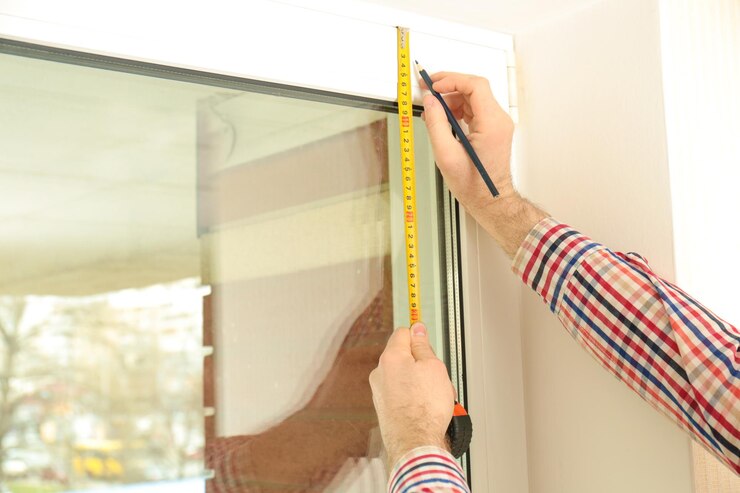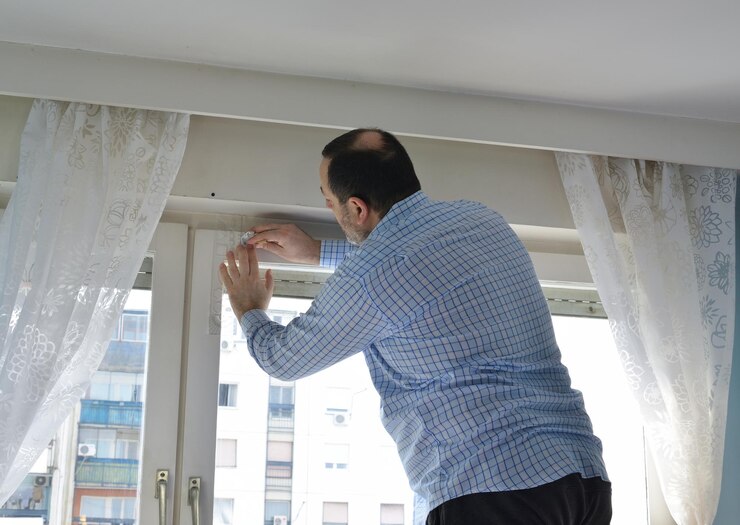
The blinds and shades market is rapidly expanding, fueled by increasing home improvement projects, urbanization, and higher household incomes. The shades segment alone is projected to grow by 5% by 2030. Among the most popular options for homeowners are vertical blinds, known for their sleek design and practicality. However, many people underestimate the challenges of vertical blinds installation. While DIY methods might seem cost-effective, common mistakes like inaccurate measurements and misaligned slats can result in both functional and aesthetic issues. Here are seven common DIY installation mistakes and why opting for expert help is the smarter, long-term solution.
Table of Contents
Key Takeaways |
✔ Accurate measurements are essential for ensuring vertical blinds fit properly and function smoothly.
✔ Incorrect bracket placement can cause blinds to hang unevenly or operate poorly.
✔ Using the right tools during vertical blinds installation ensures secure and damage-free results.
✔ Misaligned slats can lead to functional issues and a messy appearance.
✔ Window types vary, and custom adjustments are often needed for a perfect fit with vertical blinds.
✔ Properly securing cords and chains is crucial for safety, especially in homes with children or pets.
✔ Professional installation ensures a polished, functional, and safe vertical blinds setup without the common DIY mistakes.
1. Misunderstanding Measurements

Accurate measurements are the foundation of a successful vertical blinds installation, yet this is often where DIY installers go wrong. Even small inaccuracies can cause the blinds to be too short, too wide, or not fit correctly, affecting both the aesthetics and functionality of the blinds.
Why Measurements Matter
- Exact Fit: Proper measurements ensure that vertical blinds fit snugly within the window frame or over it. A poorly fitted blind can detract from the room’s look and cause operational issues, such as difficulty in opening or closing the slats.
- Avoiding Gaps: When measurements are off, you risk leaving noticeable gaps on the sides or bottom of the blinds. These gaps reduce privacy, allow excessive light to enter, and can make your blinds look like an afterthought rather than a purposeful design choice.
- Impact on Functionality: If the blinds are too long or short, they can drag on the window sill or be too loose, preventing smooth operation. This could lead to blinds getting tangled or even damaged over time, reducing their lifespan.
Common DIY Measurement Mistakes
- Measuring Only the Glass Area: Many DIYers make the mistake of measuring only the glass section, neglecting to account for the window frame. This leads to blinds that are too narrow or don’t provide adequate coverage, causing both functional and visual issues.
- Ignoring Frame Depth: When it comes to vertical blinds installation, failing to consider the depth of the window frame can cause blinds to protrude awkwardly, making it difficult for the slats to move freely. Blinds that don’t have enough clearance may also scrape the window or get stuck during operation.
- Using a Single Measurement: It’s common for DIYers to take only one measurement of width and height, assuming windows are perfectly square. However, even minor variations in the window frame can make a significant difference, resulting in an imperfect fit.
How Professionals Get It Right
- Multiple Points of Measurement: Professionals measure at several points along the width and height to account for any inconsistencies in the window frame. This ensures that the blinds fit perfectly, even if the window isn’t entirely square.
- Considering Frame Depth: When it comes to vertical blinds installation, professionals always take frame depth into account to ensure the blinds have enough clearance to operate smoothly. They use specialized tools to make sure your vertical blinds installation works flawlessly without scraping or snagging.
- Custom Fit: With advanced measurement tools, professionals guarantee a custom fit that enhances both the appearance and functionality of your vertical blinds. This level of precision is difficult to achieve in a DIY installation, making professional help invaluable.
2. Incorrect Mounting Placement

Mounting placement is crucial for vertical blinds installation, yet it’s easy to misjudge where brackets should be placed. Installing them too high, too low, or off-center can lead to crooked blinds that don’t open or close properly.
Why Mounting Placement Is Key
- Ensuring Balance: Proper bracket placement ensures the blinds hang straight and operate smoothly. Blinds that are mounted too high may look disproportionate, while those mounted too low can obstruct window sills and become hard to use.
- Smooth Operation: When it comes to vertical blinds installation, incorrect mounting can result in uneven blinds that get stuck or don’t slide smoothly along the track. This not only frustrates users but can also wear down the blinds faster, causing them to malfunction over time.
Common DIY Mounting Mistakes
- Mounting Too Close to the Ceiling: DIYers often place the brackets too high, thinking it will make the blinds look larger. However, this can cause blinds to be misaligned with the window and reduce their functional space.
- Incorrectly Centered Brackets: Off-center bracket placement leads to blinds that tilt or sway, which can be particularly noticeable with larger windows. This mistake disrupts the overall symmetry of the room, making the blinds look uneven.
How Professionals Get It Right
- Perfect Alignment: Professional installers ensure that the brackets are placed at the correct height and evenly spaced for a balanced look. This careful alignment prevents future operational issues and gives the blinds a polished, symmetrical appearance.
- Optimal Functionality: Experts know the exact placement for brackets to ensure smooth gliding along the track. With professional vertical blinds installation, you won’t have to worry about the blinds getting stuck or tilting out of alignment.
3. Using the Wrong Tools
4. Misaligned Slats
Vertical blinds installation requires specific tools to ensure the brackets are securely attached and the blinds function smoothly. Many DIYers underestimate the importance of the right tools, leading to faulty installations.
Why Tools Matter
- Secure Installation: The right tools, such as drills, anchors, and levelers, ensure that your blinds are securely mounted to the wall. Inadequate tools can cause brackets to become loose over time, which may lead to blinds falling or shifting.
- Prevention of Damage: Using improper tools can result in damage to the wall, the blinds, or both. Stripped screws or cracked window frames are common DIY mistakes that can turn a simple vertical blinds installation into a costly repair project. Remember, the more blinds you install at once, the lower the cost per window, as it reduces labor expenses.
Common DIY Tool Mistakes
- Relying on Improvised Tools: Many DIY installers try to use makeshift tools, such as screwdrivers instead of drills or household items as levels. This often leads to loose brackets that don’t hold up the weight of the blinds, causing them to sag or fall.
- Skipping Anchors for Heavy Blinds: Some DIYers neglect to use anchors when installing blinds on drywall, which can’t support the weight of vertical blinds over time. This results in the blinds pulling away from the wall, requiring reinstallation.
How Professionals Get It Right
- Specialized Tools: Professionals bring the right tools to the job, ensuring that the vertical blinds installation is both secure and clean. With drills, anchors, and levelers, they ensure that the brackets are mounted correctly and stay in place.
- Preventing Damage: Experts know how to avoid common mistakes like overtightening screws or cracking window frames. Their experience and specialized equipment ensure a smooth, damage-free installation.

Aligning slats is often more challenging than it seems, and many DIYers struggle to get them spaced correctly. Misaligned slats not only look bad but can also affect the blinds’ functionality.
Why Slat Alignment Is Important
- Visual Appeal: Evenly spaced slats create a clean and organized look. Misalignment can make the entire blinds set look off-balance, detracting from the overall appearance of the window.
- Smooth Operation: When it comes to vertical blinds installation, properly aligned slats open and close easily, while misaligned ones tend to overlap or tangle. This can cause them to catch on each other, making them difficult to operate and reducing their lifespan.
Common DIY Slat Mistakes
- Incorrect Spacing: DIYers often misjudge the spacing between slats, resulting in slats that overlap or are too far apart. This not only looks untidy but also interferes with the blinds’ operation, making them difficult to open and close.
- Reversed Slats: Some DIY installers mistakenly attach slats backward, causing them to face the wrong direction. This reduces their ability to block light and creates a mismatched look when compared to the rest of the blinds.
How Professionals Get It Right
- Perfect Spacing: Professionals ensure that the slats are evenly spaced and aligned correctly for a uniform look. Their expertise in vertical blinds installation means your blinds will function smoothly without any tangling or overlapping.
- Proper Slat Orientation: Experts ensure that all slats are installed facing the right direction, maximizing both light control and privacy. This attention to detail results in a cleaner, more polished appearance.
5. Overlooking Window Types
Not all windows are the same, and each type can require a different approach to vertical blinds installation. DIYers often overlook these variations, leading to improper installations that don’t work with the window’s design.
Why Window Type Matters
- Fit and Functionality: Different window shapes—like bay windows or irregularly shaped windows—require customized installations. Standard installation techniques may not account for these variations, resulting in blinds that don’t fit properly or function as expected.
- Aesthetic Considerations: Blinds installed without consideration of the window’s design can look out of place. Windows with unique shapes or configurations require blinds that complement their style, ensuring a cohesive look.
Common DIY Window Type Mistakes
- One-Size-Fits-All Approach: DIYers often use the same installation method for all window types, assuming that vertical blinds will fit any window. This leads to blinds that don’t operate correctly or look mismatched with the window’s shape.
- Improper Angle Adjustments: Some DIYers fail to adjust the blinds for windows with angled or curved frames, causing gaps or uneven installations. These gaps reduce privacy and allow excessive light to enter, diminishing the blinds’ effectiveness.
How Professionals Get It Right
- Tailored Installations: Professionals customize the vertical blinds installation to fit the specific window type, whether it’s a bay window, corner window, or irregularly shaped window. This ensures the blinds function smoothly and look like they were made for the window.
- Aesthetic Integration: When it comes to vertical blinds installation, experts make sure the blinds complement the window’s design, enhancing the overall look of the room. Their experience allows them to adjust the blinds perfectly, avoiding gaps and ensuring proper functionality.
6. Forgetting Safety Considerations
Safety is an often-overlooked aspect of vertical blinds installation, especially in homes with children and pets. DIY installations can leave cords or chains unsecured, creating serious hazards.
Why Safety Is Critical
- Child and Pet Safety: Loose cords and chains pose a strangulation risk for small children and pets. Ensuring these are properly secured or using cordless options can prevent dangerous accidents.
- Preventing Injuries: Blinds that are improperly installed can fall, causing injury to anyone nearby. Secure installation is essential to prevent accidents and ensure the blinds remain safely in place.
Common DIY Safety Mistakes
- Leaving Cords Unsecured: DIYers often overlook securing cords, leaving them hanging dangerously within reach of children and pets. These loose cords can quickly become hazardous if not managed correctly.
- Skipping Safety Locks: Some DIYers neglect to install safety locks or devices that secure the blinds in place, increasing the risk of the blinds falling or being pulled down by a child or pet.
How Professionals Get It Right
- Safety-First Installations: Professional installers follow strict safety guidelines, ensuring all cords are secured out of reach or using cordless systems when possible. They prioritize safety, especially in homes with children or pets, reducing the risk of accidents.
- Certified Installations: Many professional installers offer blinds that meet safety certifications, ensuring that your vertical blinds installation complies with modern safety standards. This gives you peace of mind, knowing that your home is both stylish and safe.
7. Inconsistent Aesthetic Choices

Aesthetic harmony is an essential part of home design, yet many DIY installers don’t consider how vertical blinds will fit within the room’s overall style. This often results in blinds that clash with the décor, making the room feel disjointed.
Why Aesthetic Choices Matter
- Blinds as a Design Element: Vertical blinds aren’t just functional—they also contribute to the room’s aesthetic. Choosing blinds that don’t complement the existing style can make the room feel chaotic or incomplete.
- Cohesion in Design: Properly chosen and installed blinds create a sense of cohesion within the space. When the blinds match the room’s color scheme, furniture, and architectural features, they enhance the overall design rather than detract from it.
Common DIY Aesthetic Mistakes
- Mismatched Colors and Materials: DIYers often select blinds based on personal preference, without considering the room’s color palette or materials. This leads to blinds that stand out for the wrong reasons, clashing with the room’s style.
- Ignoring the Room’s Function: Some DIYers choose blinds without thinking about the room’s primary function, such as using heavy, dark blinds in a light-filled living room. This reduces the room’s appeal and functionality.
How Professionals Get It Right
- Style Consultation: Professional installers often provide consultations to help homeowners choose blinds that match their décor. They consider factors such as color, material, and texture to ensure the vertical blinds installation enhances the room’s overall design.
- Balanced Aesthetic and Functionality: Experts help homeowners strike the perfect balance between form and function, ensuring that the blinds not only look good but also serve their intended purpose. With professional guidance, you’ll avoid aesthetic mistakes and achieve a polished, cohesive look.
Frequently Asked Questions (FAQs)
1. Can I install vertical blinds on my own without professional help?
Yes, you can install vertical blinds on your own, but it requires careful planning, precise measurements, and the right tools. While it’s possible for those with DIY experience, the process can be tricky, and mistakes may lead to issues with functionality and appearance. Hiring a professional ensures proper installation and saves time, preventing costly errors down the road.
2. How long does it take to professionally install vertical blinds?
Professional vertical blinds installation typically takes between 1 to 3 hours, depending on the number and size of the windows. More complex windows or larger spaces may take a bit longer. Professionals work efficiently to ensure the blinds are securely installed and operate smoothly without any complications, making the process quick and hassle-free compared to DIY installation.
3. Are vertical blinds a good option for sliding glass doors?
Yes, vertical blinds are an excellent choice for sliding glass doors because they are designed to cover large spaces and can be opened from side to side. This allows for easy access to the door without obstructing movement. Vertical blinds also offer great control over light and privacy, making them a practical and stylish option for sliding doors.
4. Can vertical blinds be installed on curved or angled windows?
Yes, vertical blinds can be installed on curved or angled windows, but they may require custom brackets or tracks to fit properly. While standard windows are easier to manage with a DIY approach, curved or angled windows are more complex and often need professional installation. A professional can ensure the blinds are tailored to the window’s shape, ensuring smooth operation and a perfect fit.
5. What materials are available for vertical blinds?
Vertical blinds come in various materials, including fabric, vinyl, wood, and aluminum. Each material offers different benefits, such as vinyl and aluminum being durable and easy to clean, while fabric provides a softer, more decorative look. The choice of material depends on factors like durability, maintenance, and the room’s aesthetic, and professionals can help you choose the best option for your needs.
Choose Professional Vertical Blinds Installation by East End Blinds & Window Treatments in East Hampton, NY
Transform your home with expertly installed vertical blinds from East End Blinds & Window Treatments in East Hampton, NY. Our team ensures precise installation, enhancing both the functionality and style of your space. With a commitment to quality and customer satisfaction, we handle every detail, so you can enjoy perfect window treatments that fit your lifestyle.
Contact us today to schedule your professional vertical blinds installation and elevate the look of your home.
